|
|
|
Sort Order |
|
|
|
Items / Page
|
|
|
|
|
|
|
| Srl | Item |
| 1 |
ID:
167092
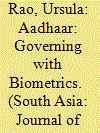

|
|
|
|
|
| Summary/Abstract |
Aadhaar means ‘foundation’ or ‘support’ in several Indian languages. Utter the word ‘aadhaar’ anywhere across the length and breadth of India today, and you will most certainly evoke India’s national biometric identification programme, the largest of its kind anywhere in the world. By the year 2019, the government had issued a twelve-digit unique ID to nearly every adult resident in India, linked to minimal biometric (fingerprints, iris scan data and facial photograph) and biographical (name, age, gender, address) information in a centralised database.
|
|
|
|
|
|
|
|
|
|
|
|
|
|
|
|
| 2 |
ID:
185595
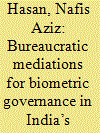

|
|
|
|
|
| Summary/Abstract |
Interrogating Aadhaar, India’s biometric ID project for its billion-plus residents, in the small north-eastern state of Tripura, where it first achieved high levels of acceptance, reveals that ‘success’ at enrolments into the database was dependent on the subversion of its celebrated biometric potentials by a local mediating bureaucracy. By limiting enrolments to previously documented subjects and enrolling Aadhaar into an ongoing regional situation of strife and reconciliation, the work of the bureaucracy highlights the contextual, territorial conditions of securitisation within which a biometric database takes shape. This paper aims to challenge claims about Aadhaar as an emblematic case of biometric governance ushering in a ‘new’ state, instead suggesting linkages with existing forms of state practices and ongoing state projects.
|
|
|
|
|
|
|
|
|
|
|
|
|
|
|
|
| 3 |
ID:
159868
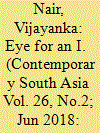

|
|
|
|
|
| Summary/Abstract |
In 2009, the Government of India embarked on a mission to issue each of India’s over one billion residents a unique biometric identification number, Aadhaar (literally, ‘foundation’). An Aadhaar database would link the demographic and biometric information (iris scans, fingerprints, facial photograph) of residents to a 12-digit number. India currently commands the world’s largest biometric database. While Aadhaar does not guarantee citizenship, benefits, or services, its architects submit that its reliable, real-time identity verification infrastructure potentially allows for the targeted delivery of any good to its intended recipient. Aadhaar is fashioned as an ID concerned with a pristine bodily uniqueness untarnished by the social, political, or economic. Aadhaar frequently provokes the questions: Who is the recipient of Aadhaar and to what community does Aadhaar afford membership? Based on ethnographic fieldwork in India’s capital, New Delhi, this article examines how Aadhaar comes to inform ideas of identity and belonging held by its implementers, as well as the population it targets.
|
|
|
|
|
|
|
|
|
|
|
|
|
|
|
|
| 4 |
ID:
167095
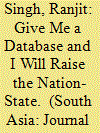

|
|
|
|
|
| Summary/Abstract |
This paper draws on an ethnographic study of Aadhaar, India’s biometrics-based national identification infrastructure, to investigate how members of its design team conceptualised and understood their techno-bureaucratic enterprise of assigning unique numbers to Indian residents. Members described their work using the metaphor of building an hour-glass: the Aadhaar number and its authentication services constitute the waist of this hour-glass; below were innovations in biometric devices and above were applications requiring identity verification services. They believed the entire ecosystem sustaining Aadhaar could be controlled by prescribing interactions between the waist and the components above and below. They extended this metaphor to reimagine the Indian government as a platform of services controlling only a specific part of a service—the waist—while opening space for innovation by integrating it with other market services above and below. This paper documents the emergence of this imaginary of ‘platformised’ government collecting real-time citizen data to support personalised state–citizen interactions to unpack how the future(s) of Indian government services shapes and is shaped by it. Such future(s) constitute the Indian population as a database, bureaucracies as centralised dashboards, and government as arbiter in the circulation of citizen data.
|
|
|
|
|
|
|
|
|
|
|
|
|
|
|
|
| 5 |
ID:
167096
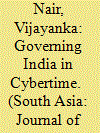

|
|
|
|
|
| Summary/Abstract |
Building on anthropological attention that has been devoted, appropriately, to the question of how states are spatialised, this article analyses how the swirl of discourse and everyday practice around India’s biometric identification programme serves to temporalise the state. The first half of the article examines how the Aadhaar initiative endeavours to assign the temporalising characteristics of innovativeness and expeditiousness to the contemporary Indian state. I show how mobility, change and speed are motivating factors for personnel at the Unique Identification Authority of India (UIDAI). In turn, I argue that Aadhaar is emblematic of the reimagination of the Indian state as a ‘start-up state’, or a lithe platform for innovation. I then explore the ways in which this start-up state is constructed in what one might call ‘cybertime’—a mode of imagining time that unsettles received understandings of historical time. In the second half of the article, I investigate how centralised efforts to temporalise the state are experienced by local implementers of Aadhaar as well as by its targets.
|
|
|
|
|
|
|
|
|
|
|
|
|
|
|
|
| 6 |
ID:
167103


|
|
|
|
|
| Summary/Abstract |
This paper departs from the analytic lens of citizen versus the state and brings to attention intra-bureaucratic interactions in the wake of Aadhaar by focusing on the ongoing implementation of an Aadhaar Enabled Biometric Attendance System (AEBAS). Based on ethnographic research in a North Indian state, I show how AEBAS’ goals of performance evaluation and management were partially, and unintentionally, circumvented by staff members, in part owing to the socio-technical design of the system. I argue that an unintended consequence of projects using digital media technologies to quantify and manage performance is their tendency to produce a performance of management, and that scholars and activists must pay attention to such disjunctures inherent in projects of command and control.
|
|
|
|
|
|
|
|
|
|
|
|
|
|
|
|
| 7 |
ID:
167102
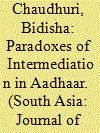

|
|
|
|
|
| Summary/Abstract |
E-governance projects in India are often purported to minimise the role of human intermediaries. They rely on machines to curtail corruption and bring more efficiency to service delivery. However, studies have found human intermediation and its affordances to be crucial, especially in developing countries where social endowment gaps pose considerable barriers to the effective use of information and communication technologies. Human intermediation in technological infrastructure is thus invisible yet inevitable. I unravel this paradox of intermediation by examining the everyday practices of two sets of intermediaries in Andhra Pradesh and Rajasthan associated with everyday workings of Aadhaar, India’s digital biometric identity infrastructure. Looking at biometric technologies as ‘situated practice’, I draw on the notion of ‘infrastructuring’ to argue that the discretionary practices of human intermediaries in fact stabilise the technological system, anchoring it to a human infrastructure. So, as disruptive technologies such as Aadhaar are implemented, their effective usage will invariably rely on the potential agency of human intermediaries and their collaborative work practices.
|
|
|
|
|
|
|
|
|
|
|
|
|
|
|
|
| 8 |
ID:
167097
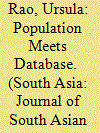

|
|
|
|
|
| Summary/Abstract |
This article traces the processes of making identities in digital India. By zooming into the two processes of enrolling in and using Aadhaar, it questions the distinction between identification and identity that pervades discussions of new technologies and shows that all Aadhaar-related procedures are productive of identity as a socially mediated process of creating or denying the condition for belonging. Following the introduction of Aadhaar, becoming a rights-bearing individual, for the most part, involves stitching together three types of identities: (1) a digital signature with (2) documentary proof of identity, both of which are based on (3) personal recognition. Aadhaar, then, does not change the ground on which official identity routines are built, but it alters the technical terrain people must navigate to become rights-bearing citizens. It adds a new layer of procedures on top of older techniques of recognition by insisting that persons must always be seen as unique individuals alongside being recognised as people holding a specific status.
|
|
|
|
|
|
|
|
|
|
|
|
|
|
|
|
| 9 |
ID:
164040
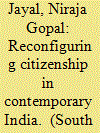

|
|
|
|
|
| Summary/Abstract |
In this paper the author revisits her book, Citizenship and Its Discontents: An Indian History (2013), to examine its central themes—status, rights and identity—in relation to political developments in India since 2014. The paper argues and provides evidence for, firstly, the greater consolidation of a jus sanguinis citizenship regime, with an attenuation of religion-neutral laws of citizenship; secondly, a shift from a rights-based conception of social citizenship to a contributory approach to welfare, now burdened with the requirement of a biometric identity; and, finally, the routinisation and normalisation of identitarian violence against Dalits and Muslims, rendering their citizenship even more precarious.
|
|
|
|
|
|
|
|
|
|
|
|
|
|
|
|
| 10 |
ID:
167094
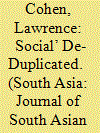

|
|
|
|
|
| Summary/Abstract |
India’s programme for biometric registration, Aadhaar, is organised through engineering concept work that depends upon three distinctive claims for the ‘social’ as human condition: (1) the social as ‘socialism’, the failed premise of Nehruvian decolonisation understood to have placed the poor into a condition of bare life; (2) the social-yet-to-come as the effect of a proper distribution of the good termed ‘service’, to bring the poor into a self-ameliorating form of life; and (3) the social as the affective entanglements that family, caste and religious ties of biography demand, ties that divert service from proper distribution. Within the concept-world of Aadhaar, such entanglements prevent the social-yet-to-come, demanding a form of government that can produce a political subject outside of biography, which for the engineers is achieved by conceiving of India as a database, an archive prone to the duplication of its elements, and thus governing India as one would govern a database: by continually ‘de-duplicating’ it.
|
|
|
|
|
|
|
|
|
|
|
|
|
|
|
|
| 11 |
ID:
167101
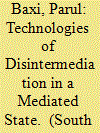

|
|
|
|
|
| Summary/Abstract |
The various lines of resistance against the Indian government’s Unique Identification Number project since its inception in 2009 form a national and publicly accessible narrative. But less is known about Aadhaar’s reception among civil society actors, non-profits who partnered with the state to implement this scheme among their constituencies. Drawing upon eighteen months of fieldwork in Mumbai, Ahmedabad and Delhi, this paper traces the nature of state and civil society engagement with Aadhaar. It demonstrates how this e-governance initiative encountered the politics and agendas of intermediary organisations long engaged in providing identity documents to the poor in the absence of state recognition of certain groups. The state sought a condition of disintermediation via biometric technology and collaborated with non-state actors to aid implementation. The failed encounter with a few non-profits working with the migrant poor demonstrates that a technocratic notion of identity and citizenship clashed with the materiality of local practices serving to maintain existing intermediations and resulting in exclusions from the Aadhaar scheme for certain groups. The paper argues that this encounter demonstrates the durability of the mediated state at a time when new technologies are deployed to remove intermediations, with consequences for the most marginalised populations.
|
|
|
|
|
|
|
|
|
|
|
|
|
|
|
|
| 12 |
ID:
117607
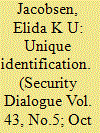

|
|
|
|
|
| Publication |
2012.
|
| Summary/Abstract |
The last decade has seen an increased focus on secured forms of identification in security governance, leading to a massive growth and standardization in the application of biometric technologies globally. This article examines what is currently the largest biometric technology project in the world: the nationwide Unique Identification (UID) number system in India. It emphasizes the importance of investigating the postcolonial contexts of governance in which biometric technology is currently being applied. Approaching the Indian scheme as a discursive/practical assemblage of multiple actors and rationales, the article investigates three contexts within which the biometric project emerged: India's Home Ministry, the Unique Identification Authority of India and a project focusing on the biometric identification of homeless people in Delhi. In particular, the article examines the various targets of intervention constructed in the discourses and practices of the national ID scheme. It is argued that the practice of biometric identification is produced as a solution to a wide array of problems of governance, both as a means of financial inclusion and as a method of surveillance.
|
|
|
|
|
|
|
|
|
|
|
|
|
|
|
|
|
|
|
|
|